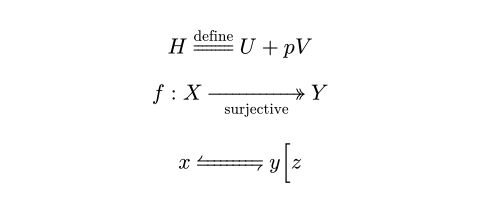翻訳済み
このページは日本語に翻訳済みです。
stretch要素関数要素関数要素関数はsetルールやshowルールでカスタマイズできます。
要素関数
要素関数は
setルールやshowルールでカスタマイズできます。字形を伸縮します。
この関数は、上部および下部アタッチメントがフィットするように、自動的にアタッチメントのベースを伸縮させることにも使えます。
伸縮可能な字形は限られており、どの字形が伸縮可能かは使用する数式フォントに依存することに注意してください。 ただし、この点に関して多くの数式フォントで違いはありません。
$ H stretch(=)^"define" U + p V $
$ f : X stretch(->>, size: #150%)_"surjective" Y $
$ x stretch(harpoons.ltrb, size: #3em) y
stretch(\[, size: #150%) z $

引数引数引数は関数への入力値です。関数名の後に括弧で囲んで指定します。
引数
引数は関数への入力値です。関数名の後に括弧で囲んで指定します。
math.stretch(,size:)->